Assessment of Structural Behavior, Vulnerability, and Risk of Industrial Silos: State-of-the-Art and Recent Research Trends
Abstract
1. Introduction
- Structural integrity and the response of the silo to gravity loads (dead loads, grain loads) [2,3], seismic loads [4,5], thermal loads [6]; the impact of the different aspects on structural behavior of silos, such as supporting system arrangements, silo-columns attachment [7,8], ring beam [9,10], imperfection measurement [11,12], imperfection-sensitivity of the shell [7,13], imperfection methods representation [14], and buckling behavior [15,16]. Furthermore, some aspects regarding the structural integrity improving [17,18] and strengthening [19] are provided.
- Properties of the bulk solids and influence on the silos’ vulnerability on the base of material properties variation [23], behavior of the stored material during discharging and its influence on design loads variation [24,25], particle-silo interaction under different load conditions, such as static and dynamic actions [26].
- Design standards of silos, looking at the main limitations, deficiencies, and possible improvements [27].
2. Structural Typology and Arrangement of Circular Silos
2.1. Construction Material and Geometry
2.2. Supporting Arrangements
2.3. Imperfections’ Effects and Modelling
2.4. Buckling Types and Analysis
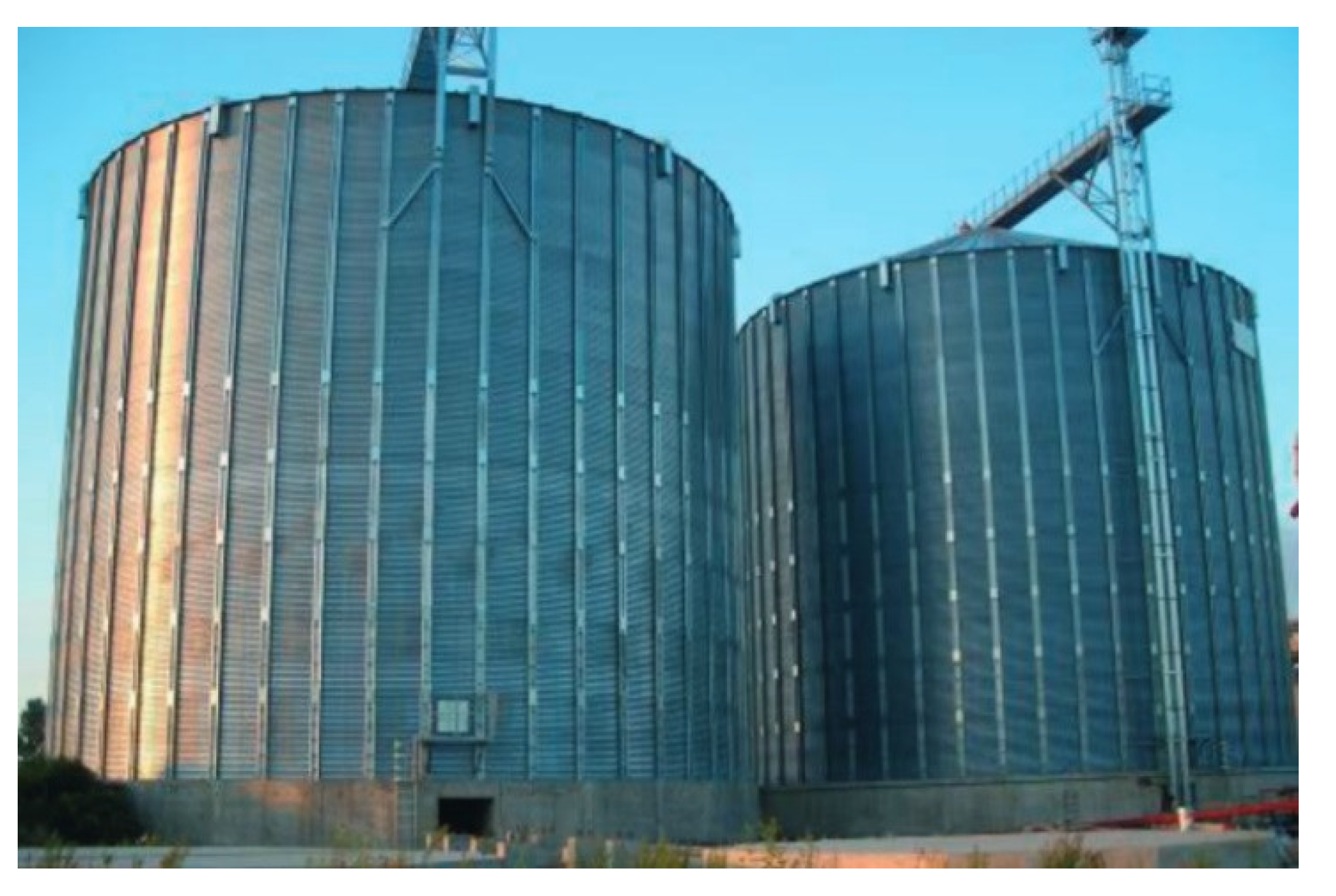
3. Earthquake Loading and Seismic Response of Silos
4. The Contained Material Properties, Behavior, and the Imposed Loads
4.1. Filling Material Properties
4.2. Discharging Patterns
5. International Standards and Solid-Induced Design Loads
5.1. EN 1991-4 (2006) “Eurocode 1: Actions on Structures—Part 4: Silos and Tanks”
5.2. ACI 313-16 (2016) “Design Specification for Concrete Silos and Stacking Tubes for Storing Granular Materials and Commentary”
5.3. AS 3774-1996 (1996) “Loads on Bulk Solids Containers”
5.4. ANSI/ASAE S433.1 JAN2019 (2019) “Loads Exerted by Free-Flowing Grain on Bins”
5.5. Loads Evaluation Philosophy According European Standards EN 1991-4:2006
6. Failures in Silos: Main Causes and Modes
7. Assessment of Steel Silos Vulnerability
8. Conclusions and Open Issues
Author Contributions
Funding
Institutional Review Board Statement
Informed Consent Statement
Data Availability Statement
Conflicts of Interest
References
- Rotter, J.M. Guide for the Economic Design of Circular Metal Silos; CRC Press: Boca Raton, FL, USA, 2001. [Google Scholar]
- Rotter, J.M. Metal silos. Prog. Struct. Eng. Mater. 1998, 1, 428–435. [Google Scholar] [CrossRef]
- Sadowski, A.; Rotter, J. Steel silos with different aspect ratios: II — behaviour under eccentric discharge. J. Constr. Steel Res. 2011, 67, 1545–1553. [Google Scholar] [CrossRef]
- Rotter, J.; Hull, T. Wall loads in squat steel silos during earthquakes. Eng. Struct. 1989, 11, 139–147. [Google Scholar] [CrossRef]
- Veletsos, A.S.; Younan, A.H. Dynamics of Solid-Containing Tanks. II: Flexible Tanks. J. Struct. Eng. 1998, 124, 62–70. [Google Scholar] [CrossRef]
- Kolb, G.J.; Lee, G.; Mijatovic, P.; Valmianski, E. Thermal ratcheting analysis of advanced thermocline energy storage tanks. In Proceedings of the presentation at the SolarPACES 2011, Granada, Spain, 20–23 September 2011. [Google Scholar]
- Jansseune, A.; De Corte, W.; Belis, J. Imperfection sensitivity of locally supported cylindrical silos subjected to uniform axial compression. Int. J. Solids Struct. 2016, 96, 92–109. [Google Scholar] [CrossRef]
- Zdravkov, L. Influencing factors on effective width of compressed zone in joint column-cylindrical shell of steel silo. Chall. J. Struct. Mech. 2018, 4, 1–8. [Google Scholar] [CrossRef]
- Topkaya, C.; Rotter, J.M. Ring Beam Stiffness Criterion for Column-Supported Metal Silos. J. Eng. Mech. 2011, 137, 846–853. [Google Scholar] [CrossRef]
- Topkaya, C.; Zeybek, Ö. Application of ring beam stiffness criterion for discretely supported shells under global shear and bending. Adv. Struct. Eng. 2018, 21, 2404–2415. [Google Scholar] [CrossRef]
- Ding, X.; Coleman, R.; Rotter, J.M. Technique for Precise Measurement of Large-Scale Silos and Tanks. J. Surv. Eng. 1996, 122, 14–25. [Google Scholar] [CrossRef]
- Coleman, R.; Ding, X.; Rotter, J.M. Measurement of imperfections in full-scale steel silos. In National Conference Publication-Institution of Engineers, Australia 2; Institution of Engineers: Canbera, Australia, 1992. [Google Scholar]
- Fajuyitan, O.K.; Sadowski, A.J. Imperfection sensitivity in cylindrical shells under uniform bending. Adv. Struct. Eng. 2018, 21, 2433–2453. [Google Scholar] [CrossRef]
- Knoedel, P.; Ummenhofer, T.; Rotter, J.M. 04.16: Rethinking imperfections in tanks and silos. Ce/papers 2017, 1, 960–969. [Google Scholar] [CrossRef]
- Rotter, J.; Jumikis, P.; Fleming, S.; Porter, S. Experiments on the buckling of thin-walled model silo structures. J. Constr. Steel Res. 1989, 13, 271–299. [Google Scholar] [CrossRef]
- Sadowski, A.J.; Rotter, J.M. Buckling of very slender metal silos under eccentric discharge. Eng. Struct. 2011, 33, 1187–1194. [Google Scholar] [CrossRef]
- Ning, X.; Pellegrino, S. Imperfection-insensitive axially loaded cylindrical shells. In Proceedings of the 54th AIAA/ASME/ASCE/AHS/ASC Structures, Structural Dynamics and Materials Conference, Boston, MA, USA, 8–11 April 2013. [Google Scholar]
- Jäger-Cañás, A.; Pasternak, H. 04.13: Influence of closely spaced ring-stiffeners on the axial buckling behavior of cylindrical shells. Ce/papers 2017, 1, 928–937. [Google Scholar] [CrossRef]
- Batikha, M.; Chen, J.-F.; Rotter, J.M. Fibre reinforced polymer for strengthening cylindrical metal shells against elephant’s foot buckling: An elasto-plastic analysis. Adv. Struct. Eng. 2018, 21, 2483–2498. [Google Scholar] [CrossRef]
- Younan, A.H.; Veletsos, A.S. Dynamics of Solid-Containing Tanks. I: Rigid Tanks. J. Struct. Eng. 1998, 124, 52–61. [Google Scholar] [CrossRef]
- Silvestri, S.; Gasparini, G.; Trombetti, T.; Foti, D. On the evaluation of the horizontal forces produced by grain-like material inside silos during earthquakes. Bull. Earthq. Eng. 2012, 10, 1535–1560. [Google Scholar] [CrossRef]
- Temsah, Y.; Jahami, A.; Aouad, C. Silos structural response to blast loading. Eng. Struct. 2021, 243, 112671. [Google Scholar] [CrossRef]
- Molenda, M.; Horabik, J.; Thompson, S.; Ross, I. Effects of grain properties on loads in model silo. Int. Agrophysics 2004, 18, 329–332. [Google Scholar]
- Kobyłka, R.; Molenda, M.; Horabik, J. DEM simulation of the pressure distribution and flow pattern in a model grain silo with an annular segment attached to the wall. Biosyst. Eng. 2020, 193, 75–89. [Google Scholar] [CrossRef]
- Volpato, S.; Artoni, R.; Santomaso, A.C. Numerical study on the behavior of funnel flow silos with and without inserts through a continuum hydrodynamic approach. Chem. Eng. Res. Des. 2014, 92, 256–263. [Google Scholar] [CrossRef]
- Chen, Z.; Wassgren, C.; Veikle, E.; Ambrose, K. Determination of material and interaction properties of maize and wheat kernels for DEM simulation. Biosyst. Eng. 2020, 195, 208–226. [Google Scholar] [CrossRef]
- Carson, J.; Craig, D. Silo Design Codes: Their Limits and Inconsistencies. Procedia Eng. 2015, 102, 647–656. [Google Scholar] [CrossRef][Green Version]
- Maj, M. Some Causes of Reinforced Concrete Silos Failure. Procedia Eng. 2017, 172, 685–691. [Google Scholar] [CrossRef]
- Zaccari, N.; Cudemo, M. Steel silo failure and reinforcement proposal. Eng. Fail. Anal. 2016, 63, 1–11. [Google Scholar] [CrossRef]
- Singer, J.; Arbocz, J.; Weller, T. Experimental methods in buckling of thin-walled structures. In Buckling Experiments, 2nd ed.; Johm Wiley & Sons: New York, NY, USA, 2002; pp. 1244–1284. ISBN 978-0-471-97450-5. [Google Scholar]
- Ding, X.; Coleman, R.; Rotter, J.M. Surface Profiling System for Measurement of Engineering Structures. J. Surv. Eng. 1996, 122, 3–13. [Google Scholar] [CrossRef]
- Castro, S.G.; Zimmermann, R.; Arbelo, M.A.; Khakimova, R.; Hilburger, M.W.; Degenhardt, R. Geometric imperfections and lower-bound methods used to calculate knock-down factors for axially compressed composite cylindrical shells. Thin Walled Struct. 2014, 74, 118–132. [Google Scholar] [CrossRef]
- Janssen, H.A. Versuche uber getreidedruck in silozellen. Z. Ver. Dtsch. Ing. 1895, 39, 1045–1049. [Google Scholar]
- Vidal, P.; Guaita, M.; Ayuga, F. Analysis of Dynamic Discharge Pressures in Cylindrical Slender Silos with a Flat Bottom or with a Hopper: Comparison with Eurocode 1. Biosyst. Eng. 2005, 91, 335–348. [Google Scholar] [CrossRef]
- Kanyilmaz, A.; Castiglioni, C.A. Reducing the seismic vulnerability of existing elevated silos by means of base isolation devices. Eng. Struct. 2017, 143, 477–497. [Google Scholar] [CrossRef]
- WorkCover, (New south wales) Safety Aspects in the Design of Bulk Solids Containers Including Silos, Field Bins and Chaser Bins, Code of Practice-2005. Available online: www.workcover.nsw.gov.au (accessed on 20 December 2021).
- Zeybek, Ö.; Seçer, M. A design approach for the ring girder in elevated steel silos. Thin Walled Struct. 2020, 157, 107002. [Google Scholar] [CrossRef]
- Jansseune, A.; De Corte, W.; Van Impe, R. Column-supported silos: Elasto-plastic failure. Thin Walled Struct. 2013, 73, 158–173. [Google Scholar] [CrossRef]
- Gillie, M.; Holst, J. Structural behaviour of silos supported on discrete, eccentric brackets. J. Constr. Steel Res. 2003, 59, 887–910. [Google Scholar] [CrossRef]
- Jansseune, A.; De Corte, W.; Belis, J.J. Elastic failure of locally supported silos with U-shaped longitudinal stiffeners. KSCE J. Civ. Eng. 2015, 19, 1041–1049. [Google Scholar] [CrossRef]
- Doerich, C.; Rotter, J.M. Behavior of Cylindrical Steel Shells Supported on Local Brackets. J. Struct. Eng. 2008, 134, 1269–1277. [Google Scholar] [CrossRef]
- Khalili, F.; Showkati, H. T-ring stiffened cone cylinder intersection under internal pressure. Thin Walled Struct. 2012, 54, 54–64. [Google Scholar] [CrossRef]
- Zeybek, Ö.; Topkaya, C.; Rotter, J.M. Analysis of silo supporting ring beams resting on discrete supports. Thin Walled Struct. 2018, 135, 285–296. [Google Scholar] [CrossRef]
- Vlasov, V.Z. Thin-Walled Elastic Beams, National Science Foundation; National Science Foundation: Washington, DC, USA, 1961. [Google Scholar]
- Rotter, J.M.; Teng, J. Elastic Stability of Cylindrical Shells with Weld Depressions. J. Struct. Eng. 1989, 115, 1244–1263. [Google Scholar] [CrossRef]
- Rotter, J.M. Development of Proposed European Design Rules for Buckling of Axially Compressed Cylinders. Adv. Struct. Eng. 1998, 1, 273–286. [Google Scholar] [CrossRef]
- Teng, J.; Lin, X.; Rotter, J.M.; Ding, X. Analysis of geometric imperfections in full-scale welded steel silos. Eng. Struct. 2005, 27, 938–950. [Google Scholar] [CrossRef]
- Wagner, H.N.R.; Hühne, C.; Janssen, M. Buckling of cylindrical shells under axial compression with loading imperfections: An experimental and numerical campaign on low knockdown factors. Thin Walled Struct. 2020, 151, 106764. [Google Scholar] [CrossRef]
- Ning, X.; Pellegrino, S. Imperfection-insensitive axially loaded thin cylindrical shells. Int. J. Solids Struct. 2015, 62, 39–51. [Google Scholar] [CrossRef]
- Rotter, J.M. Cylindrical shells under axial compression. In Buckling of Thin Metal Shells; CRC Press: Boca Raton, FL, USA, 2006; pp. 66–111. [Google Scholar]
- Southwell, R.V.V. On the general theory of elastic stability. Philos. Trans. R. Soc. London Ser. A Contain. Pap. A Math. Phys. Character 1914, 213, 187–244. [Google Scholar] [CrossRef]
- Simitses, G.J. Buckling and Postbuckling of Imperfect Cylindrical Shells: A Review. Appl. Mech. Rev. 1986, 39, 1517–1524. [Google Scholar] [CrossRef]
- Von Karman, T.; Tsien, H.-S. The Buckling of Thin Cylindrical Shells Under Axial Compression. J. Aeronaut. Sci. 1941, 8, 303–312. [Google Scholar] [CrossRef]
- Bisagni, C. Numerical analysis and experimental correlation of composite shell buckling and post-buckling. Compos. Part B Eng. 2000, 31, 655–667. [Google Scholar] [CrossRef]
- Winterstetter, T.; Schmidt, H. Stability of circular cylindrical steel shells under combined loading. Thin Walled Struct. 2002, 40, 893–910. [Google Scholar] [CrossRef]
- Teng, J.; Song, C. Numerical models for nonlinear analysis of elastic shells with eigenmode-affine imperfections. Int. J. Solids Struct. 2001, 38, 3263–3280. [Google Scholar] [CrossRef]
- Ismail, M.; Purbolaksono, J.; Andriyana, A.; Tan, C.; Muhammad, N.; Liew, H. The use of initial imperfection approach in design process and buckling failure evaluation of axially compressed composite cylindrical shells. Eng. Fail. Anal. 2015, 51, 20–28. [Google Scholar] [CrossRef]
- Elishakoff, I.; Van Manen, S.; Vermeulen, P.G.; Arbocz, J. First-order second-moment analysis of the buckling of shells with random imperfections. AIAA J. 1987, 25, 1113–1117. [Google Scholar] [CrossRef]
- Wagner, H.N.R.; Hühne, C.; Niemann, S.; Khakimova, R. Robust design criterion for axially loaded cylindrical shells - Simulation and Validation. Thin Walled Struct. 2017, 115, 154–162. [Google Scholar] [CrossRef]
- Kriegesmann, B.; Rolfes, R.; Hühne, C.; Teßmer, J.; Arbocz, J. Probabilistic design of axially compressed composite cylinders with geometric and loading imperfections. Int. J. Struct. Stab. Dyn. 2010, 10, 623–644. [Google Scholar] [CrossRef]
- Hühne, C.; Rolfes, R.; Breitbach, E.; Teßmer, J. Robust design of composite cylindrical shells under axial compression—Simulation and validation. Thin Walled Struct. 2008, 46, 947–962. [Google Scholar] [CrossRef]
- Jiao, P.; Chen, Z.; Tang, X.; Su, W.; Wu, J. Design of axially loaded isotropic cylindrical shells using multiple perturbation load approach – Simulation and validation. Thin Walled Struct. 2018, 133, 1–16. [Google Scholar] [CrossRef]
- Khakimova, R.; Castro, S.; Wilckens, D.; Rohwer, K.; Degenhardt, R. Buckling of axially compressed CFRP cylinders with and without additional lateral load: Experimental and numerical investigation. Thin Walled Struct. 2017, 119, 178–189. [Google Scholar] [CrossRef]
- Peterson, P.; Seide, P.; Weingarten, V. Buckling of Thin-walled Circular Cylinders; Technical Report No. SP-8007; NASA Langley Research Center: Hampton, VA, USA, 1968. [Google Scholar]
- Arbelo, M.A.; Degenhardt, R.; Castro, S.G.; Zimmermann, R. Numerical characterization of imperfection sensitive composite structures. Compos. Struct. 2014, 108, 295–303. [Google Scholar] [CrossRef]
- Pircher, M.; Bridge, R. Effects of weld-induced circumferential imperfections on the buckling of cylindrical thin-walled shells. WIT Trans. Eng. Sci. 1998, 19. [Google Scholar] [CrossRef]
- Sadowski, A.J.; Rotter, J.M. Study of Buckling in Steel Silos under Eccentric Discharge Flows of Stored Solids. J. Eng. Mech. 2010, 136, 769–776. [Google Scholar] [CrossRef]
- Teng, J.G.; Rotter, J.M. Buckling of Thin Metal Shells; CRC Press: Boca Raton, FL, USA, 2004; ISBN 1482295075, 9781482295078. [Google Scholar] [CrossRef]
- Teng, J.G. Buckling of Thin Shells: Recent Advances and Trends. Appl. Mech. Rev. 1996, 49, 263–274. [Google Scholar] [CrossRef]
- Dogangun, A.; Karaca, Z.; Durmus, A.; Sezen, H. Cause of Damage and Failures in Silo Structures. J. Perform. Constr. Facil. 2009, 23, 65–71. [Google Scholar] [CrossRef]
- EN 1991-4, Eurocode 1-Actions on Structures-Part 4: Silos and Tanks; European Committee for Standardization: Brussels, Belgium, 2006.
- EN 1993-1-6, Eurocode 3-Design of Steel Structures-Part 1–6: Strength and Stability of Shell Structures; European Committee for Standardization: Brussels, Belgium, 2007.
- Błażejewski, P.; Marcinowski, J. Buckling resistance of vertical stiffeners of steel silos for grain storage. Bud. Arch. 2013, 12, 189–196. [Google Scholar] [CrossRef]
- Flügge, W. Die Stabilität der Kreiszylinderschale. Ing. Arch. 1932, 3, 463–506. [Google Scholar] [CrossRef]
- Singer, J. Buckling of Integrally Stiffened Cylindrical Shells-a Review of Experiment and Theory; Delft University Press: Delft, The Netherlands, 1972. [Google Scholar]
- Hao, P.; Wang, B.; Tian, K.; Li, G.; Du, K.; Niu, F. Efficient Optimization of Cylindrical Stiffened Shells with Reinforced Cutouts by Curvilinear Stiffeners. AIAA J. 2016, 54, 1350–1363. [Google Scholar] [CrossRef]
- Wang, B.; Tian, K.; Hao, P.; Zheng, Y.; Ma, Y.; Wang, J. Numerical-based smeared stiffener method for global buckling analysis of grid-stiffened composite cylindrical shells. Compos. Struct. 2016, 152, 807–815. [Google Scholar] [CrossRef]
- Rejowski, K.; Iwicki, P. Buckling analysis of cold formed silo column. Mech. Mech. Eng. 2016, 20, 109–120. [Google Scholar]
- Uckan, E.; Akbas, B.; Shen, J.; Wen, R.; Turandar, K.; Erdik, M. Seismic performance of elevated steel silos during Van earthquake, October 23, 2011. Nat. Hazards 2014, 75, 265–287. [Google Scholar] [CrossRef]
- Li, Z.; Pasternak, H.; Jäger-Cañás, A. Buckling of ring-stiffened cylindrical shell under axial compression: Experiment and numerical simulation. Thin Walled Struct. 2021, 164, 107888. [Google Scholar] [CrossRef]
- Malhotra, P.K.; Wenk, T.; Wieland, M. Simple Procedure for Seismic Analysis of Liquid-Storage Tanks. Struct. Eng. Int. 2000, 10, 197–201. [Google Scholar] [CrossRef]
- Guo, K.; Zhou, C.; Meng, L.; Zhang, X. Seismic vulnerability assessment of reinforced concrete silo considering granular material-structure interaction. Struct. Des. Tall Spéc. Build. 2016, 25, 1011–1030. [Google Scholar] [CrossRef]
- Mehretehran, A.M.; Maleki, S. 3D buckling assessment of cylindrical steel silos of uniform thickness under seismic action. Thin Walled Struct. 2018, 131, 654–667. [Google Scholar] [CrossRef]
- Mansour, S.; Pieraccini, L.; Palermo, M.; Foti, D.; Gasparini, G.; Trombetti, T.; Silvestri, S. Comprehensive Review on the Dynamic and Seismic Behavior of Flat-Bottom Cylindrical Silos Filled With Granular Material. Front. Built Environ. 2022, 7, 805014. [Google Scholar] [CrossRef]
- Silvestri, S.; Ivorra, S.; Di Chiacchio, L.; Trombetti, T.; Foti, D.; Gasparini, G.; Pieraccini, L.; Dietz, M.; Taylor, C. Shaking-table tests of flat-bottom circular silos containing grain-like material. Earthq. Eng. Struct. Dyn. 2015, 45, 69–89. [Google Scholar] [CrossRef]
- Holler, S.; Meskouris, K. Granular Material Silos under Dynamic Excitation: Numerical Simulation and Experimental Validation. J. Struct. Eng. 2006, 132, 1573–1579. [Google Scholar] [CrossRef]
- EN 1998-4, Eurocode 8-Design of Structures for Earthquake Resistance-Part 4-Silos, Tanks and Pipelines; European Committee for Standardization: Brussels, Belgium, 2006.
- Yakhchalian, M.; Nateghi, F. Seismic behavior of silos with different height to diameter ratios considering granular material-structure interaction. Int. J. Eng. 2012, 25, 25–35. [Google Scholar] [CrossRef]
- Nateghi, F.; Yakhchalian, M. Seismic Behavior of Reinforced Concrete Silos Considering Granular Material-Structure Interaction. Procedia Eng. 2011, 14, 3050–3058. [Google Scholar] [CrossRef]
- Pieraccini, L.; Silvestri, S.; Trombetti, T. Refinements to the Silvestri’s theory for the evaluation of the seismic actions in flat-bottom silos containing grain-like material. Bull. Earthq. Eng. 2015, 13, 3493–3525. [Google Scholar] [CrossRef]
- Pieraccini, L.; Palermo, M.; Silvestri, S.; Trombetti, T. On the Fundamental Periods of Vibration of Flat-Bottom Ground-Supported Circular Silos containing Gran-like Material. Procedia Eng. 2017, 199, 248–253. [Google Scholar] [CrossRef]
- Durmuş, A.; Livaoglu, R. A simplified 3 D.O.F. model of A FEM model for seismic analysis of a silo containing elastic material accounting for soil–structure interaction. Soil Dyn. Earthq. Eng. 2015, 77, 1–14. [Google Scholar] [CrossRef]
- Butenweg, C.; Rosin, J.; Holler, S. Analysis of Cylindrical Granular Material Silos under Seismic Excitation. Buildings 2017, 7, 61. [Google Scholar] [CrossRef]
- Mehretehran, A.M.; Maleki, S. Seismic response and failure modes of steel silos with isotropic stepped walls: The effect of vertical component of ground motion and comparison of buckling resistances under seismic actions with those under wind or discharge loads. Eng. Fail. Anal. 2020, 120, 105100. [Google Scholar] [CrossRef]
- Silvestri, S.; Mansour, S.; Marra, M.; Distl, J.; Furinghetti, M.; Lanese, I.; Hernández-Montes, E.; Neri, C.; Palermo, M.; Pavese, A.; et al. Shaking table tests of a full-scale flat-bottom manufactured steel silo filled with wheat: Main results on the fixed-base configuration. Earthq. Eng. Struct. Dyn. 2021, 51, 169–190. [Google Scholar] [CrossRef]
- Jing, H.; Chen, H.; Yang, J.; Li, P. Shaking table tests on a small-scale steel cylindrical silo model in different filling conditions. Structures 2022, 37, 698–708. [Google Scholar] [CrossRef]
- Castiglioni, C.A.; Kanyilmaz, A. Simplified numerical modeling of elevated silos for nonlinear dynamic analysis. Ing. Sismica Int. J. Earthq. Eng. 2015, 33, 5–14. [Google Scholar]
- Maj, M.; Ubysz, A. Computational Models for Determining Silo Wall Displacements Caused by Dry Friction; Oficyna Wydawnicza Politechniki Wrocławskiej: Wrocław, Poland, 2020. [Google Scholar]
- AS 3774-1996, Loads on Bulk Solids Containers; Standards Australia: Sidney, Australia, 1996.
- ACI 313-16:2016 Design Specification for Concrete Silos and Stacking Tubes for Storing Granular Materials and Commentary; American Concrete Institute: Farmington Hills, MI, USA, 2016.
- Molenda, M. Effect of structure of seeds bedding on stress state. Acta Agrophysica 1998, 12, 3–129. [Google Scholar]
- Schulze, D.; Schwedes, J.; Carson, J.W. Powders and Bulk Solids, Behavior, Characterization, Storage and Flow; Springer: Berlin/Heidelberg, Germany, 2021; ISBN 978-3-030-76719-8. [Google Scholar]
- Horabik, J.; Molenda, M. Properties of grain for silo strength calculation. In Physical Methods in Agriculture; Springer: Boston, MA, USA, 2002; pp. 195–217. [Google Scholar] [CrossRef]
- Airy, W. The pressure of grain. In Minutes of the Proceedings of the Institution of Civil Engineers; Thomas Telford-ICE Virtual Library: London, UK, 1898; Volume 131, pp. 347–358. [Google Scholar] [CrossRef]
- Reimbert, M.L.; Reimbert, A.M. Silos: Theory and Practice; Trans Tech Publications Ltd.: Zurich, Switzerland, 1976. [Google Scholar]
- DIN 1055-6, 2005, Actions on Structures – Part 6: Design Loads for Buildings and Loads in Silo Bins; Beuth Verlag: Berlin, Germany, 2014.
- Härtl, J.; Ooi, J.; Rotter, J.; Wojcik, M.; Ding, S.; Enstad, G. The influence of a cone-in-cone insert on flow pattern and wall pressure in a full-scale silo. Chem. Eng. Res. Des. 2008, 86, 370–378. [Google Scholar] [CrossRef]
- Khouri, M. Comparison of various methods used in the analysis of silos without wall friction. WIT Trans. Model. Simul. 2005, 41, 425–441. [Google Scholar]
- ANSI/ASAE. S433.1 Loads Exerted by Free-Flowing Grain on Bins; ANSI: Washington, DC, USA, 2019. [Google Scholar]
- Walker, D. An approximate theory for pressures and arching in hoppers. Chem. Eng. Sci. 1966, 21, 975–997. [Google Scholar] [CrossRef]
- Muite, B.K.; Quinn, S.F.; Sundaresan, S.; Rao, K.K. Silo music and silo quake: Granular flow-induced vibration. Powder Technol. 2004, 145, 190–202. [Google Scholar] [CrossRef]
- Liu, Y.; Gonzalez, M.; Wassgren, C. Modeling granular material segregation using a combined finite element method and advection–diffusion–segregation equation model. Powder Technol. 2019, 346, 38–48. [Google Scholar] [CrossRef]
- Rotter, J.M. Silos and Tanks in Research and Practice: State of the Art and Current Challenges; Editorial Universitat Politècnica de València: Valencia, Spain, 2009; Available online: http://hdl.handle.net/10251/6466 (accessed on 24 February 2022).
- Maraveas, C. Concrete Silos: Failures, Design Issues and Repair/Strengthening Methods. Appl. Sci. 2020, 10, 3938. [Google Scholar] [CrossRef]
- Rotter, J.M. Elephant's foot buckling in pressurised cylindrical shells. Stahlbau 2006, 75, 742–747. [Google Scholar] [CrossRef]
- Carson, J.W.; Holmes, T. Silo failures: Why do they happen? TASK Q. 2003, 7, 499–512. [Google Scholar]
- Carson, J.W. Jenkyn, R. Load development and structural considerations in silo design. In Reliable Flow of Particulate Solids II; Powder Science and Technology Research: Oslo, Norway, 1993. [Google Scholar]
- Kobyłka, R.; Molenda, M.; Horabik, J. Loads on grain silo insert discs, cones, and cylinders: Experiment and DEM analysis. Powder Technol. 2018, 343, 521–532. [Google Scholar] [CrossRef]
- Hammadeh, H.; Askifi, F.; Ubysz, A.; Maj, M.; Zeno, A. Effect of using insert on the flow pressure in cylindrical silo. Stud. Geotech. et Mech. 2019, 41, 177–183. [Google Scholar] [CrossRef]
- Horabik, J.; Molenda, M.; Ross, I. Application of the anisotropy of mechanical properties of bedding of grain for reduction of silo load asymmetry resulting from off-center discharge. Acta Agrophysica 2021, 2002, 49–60. [Google Scholar]
- Horabik, J.; Wiącek, J.; Parafiniuk, P.; Bańda, M.; Kobyłka, R.; Stasiak, M.; Molenda, M. Calibration of discrete-element-method model parameters of bulk wheat for storage. Biosyst. Eng. 2020, 200, 298–314. [Google Scholar] [CrossRef]
- Saleh, K.; Golshan, S.; Zarghami, R. A review on gravity flow of free-flowing granular solids in silos—Basics and practical aspects. Chem. Eng. Sci. 2018, 192, 1011–1035. [Google Scholar] [CrossRef]
- Puzrin, A.M.; Alonso, E.E.; Pinyol, N.M. Bearing Capacity Failure: Transcona Grain Elevator, Canada, Geomechanics of Failures; Springer: Dordrecht, The Netherlands, 2010; pp. 67–84. [Google Scholar] [CrossRef]
- A Case of Foundation Soil Failure–the Transcona Grain Elevator. Geotech. Available online: https://www.geotech.hr/en/case-of-foundation-soil-failure-transcona-grain-elevator/ (accessed on 20 December 2021).
- Liu, C.; Fang, D. Robustness analysis of vertical resistance to progressive collapse of diagrid structures in tall buildings. Struct. Des. Tall Spéc. Build. 2020, 29, e1775. [Google Scholar] [CrossRef]
- Kenneth, S.B. Progressive failure and imminent collapse of a steel storage silo. Forensic Eng. 2003, 29, 508–517. [Google Scholar] [CrossRef]
- Liu, C.; Fang, D.; Zhao, L. Reflection on earthquake damage of buildings in 2015 Nepal earthquake and seismic measures for post-earthquake reconstruction. In Structures; Elsevier: Amsterdam, The Netherlands, 2021; Volume 30, pp. 647–658. [Google Scholar] [CrossRef]
- Liu, C.; Fang, D.; Yan, Z. Seismic Fragility Analysis of Base Isolated Structure Subjected to Near-fault Ground Motions. Period. Polytech. Civ. Eng. 2021, 65, 768–783. [Google Scholar] [CrossRef]
- Sun, X.; Tao, X.; Duan, S.; Liu, C. Kappa (k) derived from accelerograms recorded in the 2008 Wenchuan mainshock, Sichuan, China. J. Asian Earth Sci. 2013, 73, 306–316. [Google Scholar] [CrossRef]
- Basone, F.; Wenzel, M.; Bursi, O.S.; Fossetti, M. Finite locally resonant Metafoundations for the seismic protection of fuel storage tanks. Earthq. Eng. Struct. Dyn. 2018, 48, 232–252. [Google Scholar] [CrossRef]
- Paolacci, F.; Giannini, R.; De, M. Analysis of the Seismic Risk of Major-Hazard Industrial Plants and Applicability of Innovative Seismic Protection Systems. Petrochemicals 2012, 39, 223–248. [Google Scholar] [CrossRef][Green Version]
- Kebeli, H.; Bucklin, R.; Ellifritt, D.; Chau, K. Moisture-induced pressures and loads in grain bins. Trans. ASAE 2000, 43, 1211. [Google Scholar] [CrossRef]
- Sassine, N.; Donzé, F.-V.; Harthong, B.; Bruch, A. Thermal stress numerical study in granular packed bed storage tank. Granul. Matter 2018, 20, 44. [Google Scholar] [CrossRef]
- Eckhoff, R.K. Dust Explosion Prevention and Mitigation, Status and Developments in Basic Knowledge and in Practical Application. Int. J. Chem. Eng. 2009, 2009, 1–12. [Google Scholar] [CrossRef]
- Skjold, T.; Eckhoff, R.K. Dust explosions in the process industries: Research in the twenty-first century. Chem. Eng. Trans. 2016, 48, 337–342. [Google Scholar] [CrossRef]
- Pineau, J.-P.; Masson, F. Explosion in a grain silo Blaye (France). In Proceedings of the Symposium “Safe Handling of Combustible Dusts”, Nuremberg, Germany, March 2001. [Google Scholar]
- Masson, F. Explosion of a Grain Silo, Blaye (France): Summary Report; Ministry for National and Regional Development and the Environment: Paris, France, 1998. [Google Scholar]
- Tascón, A. Design of silos for dust explosions: Determination of vent area sizes and explosion pressures. Eng. Struct. 2017, 134, 1–10. [Google Scholar] [CrossRef]
- Maj, M.; Ubysz, A. Estimation of loads’ main statistics for hot materials silo. In IOP Conference Series: Materials Science and Engineering; IOP Publishing: Bristol, UK, 2020; Volume 869, p. 052042. [Google Scholar]
- EN 61241-17, Electrical Apparatus for Use in the Presence of Combustible Dust-Part 17: Inspection and Maintenance of Electrical Installations in Hazardous Areas (Other Than Mines); European Committee for Electrotechnical Standardization: Brussels, Belgium, 2005.
- EN 50281-3, Equipment for Use in the Presence of Combustible Dust-Part 3: Classification of Areas where Combustible Dusts Are or May be Present; European Committee for Electrotechnical Standardization: Brussels, Belgium, 2002.
- Galletly, G.D.; Slankard, R.C.; Wenk, E. General Instability of Ring-Stiffened Cylindrical Shells Subject to External Hydrostatic Pressure—A Comparison of Theory and Experiment. J. Appl. Mech. 1958, 25, 259–266. [Google Scholar] [CrossRef]
- Kalnins, K.; Arbelo, M.; Ozolins, O.; Skukis, E.; Castro, S.; Degenhardt, R. Experimental Nondestructive Test for Estimation of Buckling Load on Unstiffened Cylindrical Shells Using Vibration Correlation Technique. Shock Vib. 2015, 2015, 1–8. [Google Scholar] [CrossRef]
- Lurie, H. Lateral Vibrations as Related to Structural Stability. Ph.D. Thesis, California Institute of Technology, Pasadena, CA, USA, 1950. [Google Scholar] [CrossRef]
- Arbelo, M.; Almeida, S.; Donadon, M.V.; Rett, S.R.; Degenhardt, R.; Castro, S.; Kalnins, K.; Ozoliņš, O. Vibration correlation technique for the estimation of real boundary conditions and buckling load of unstiffened plates and cylindrical shells. Thin Walled Struct. 2014, 79, 119–128. [Google Scholar] [CrossRef]
- Skukis, E.; Ozolins, O.; Kalnins, K.; Arbelo, M.A. Experimental Test for Estimation of Buckling Load on Unstiffened Cylindrical shells by Vibration Correlation Technique. Procedia Eng. 2017, 172, 1023–1030. [Google Scholar] [CrossRef]
- Chailleux, A.; Hans, Y.; Verchery, G. Experimental study of the buckling of laminated composite columns and plates. Int. J. Mech. Sci. 1975, 17, 489-IN2. [Google Scholar] [CrossRef]
- Rosen, A.; Singer, J. Vibrations and buckling of axially loaded stiffened cylindrical shells with elastic restraints. Int. J. Solids Struct. 1976, 12, 577–588. [Google Scholar] [CrossRef]
- Singer, J.; Abramovich, H. Vibration Techniques for Definition of Practical Boundary Conditions in Stiffened Shells. AIAA J. 1979, 17, 762–769. [Google Scholar] [CrossRef]
- Skukis, E.; Ozolins, O.; Andersons, J.; Kalnins, K.; Arbelo, M. Applicability of the Vibration Correlation Technique for Estimation of the Buckling Load in Axial Compression of Cylindrical Isotropic Shells with and without Circular Cutouts. Shock Vib. 2017, 2017, 1–14. [Google Scholar] [CrossRef]
- Franzoni, F.; Degenhardt, R.; Albus, J.; Arbelo, M. Vibration correlation technique for predicting the buckling load of imperfection-sensitive isotropic cylindrical shells: An analytical and numerical verification. Thin Walled Struct. 2019, 140, 236–247. [Google Scholar] [CrossRef]
- Żmuda-Trzebiatowski, Ł.; Iwicki, P. Impact of Geometrical Imperfections on Estimation of Buckling and Limit Loads in a Silo Segment Using the Vibration Correlation Technique. Materials 2021, 14, 567. [Google Scholar] [CrossRef]
- Morelli, F.; Laguardia, R.; Faggella, M.; Piscini, A.; Gigliotti, R.; Salvatore, W. Ground motions and scaling techniques for 3D performance based seismic assessment of an industrial steel structure. Bull. Earthq. Eng. 2017, 16, 1179–1208. [Google Scholar] [CrossRef]

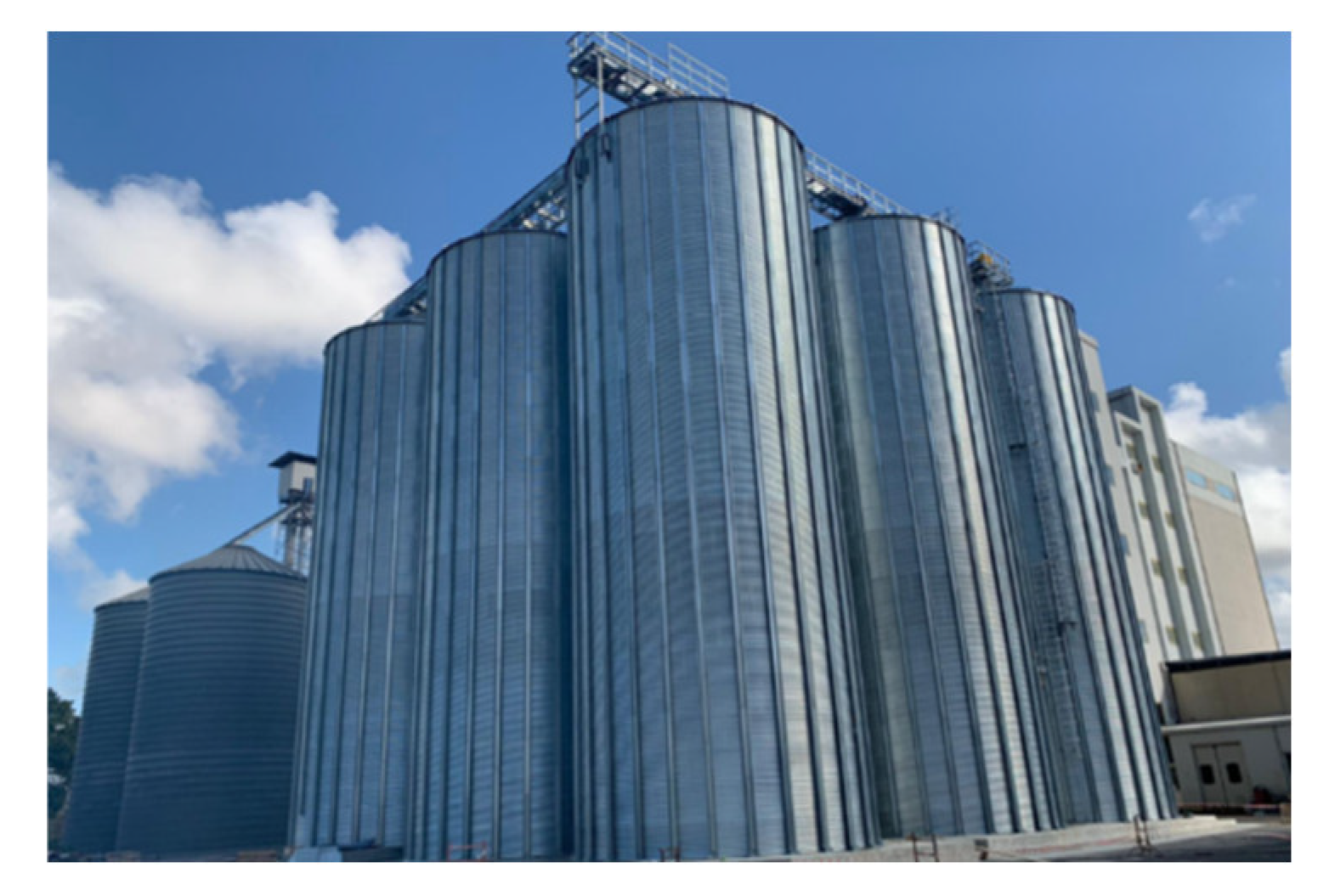
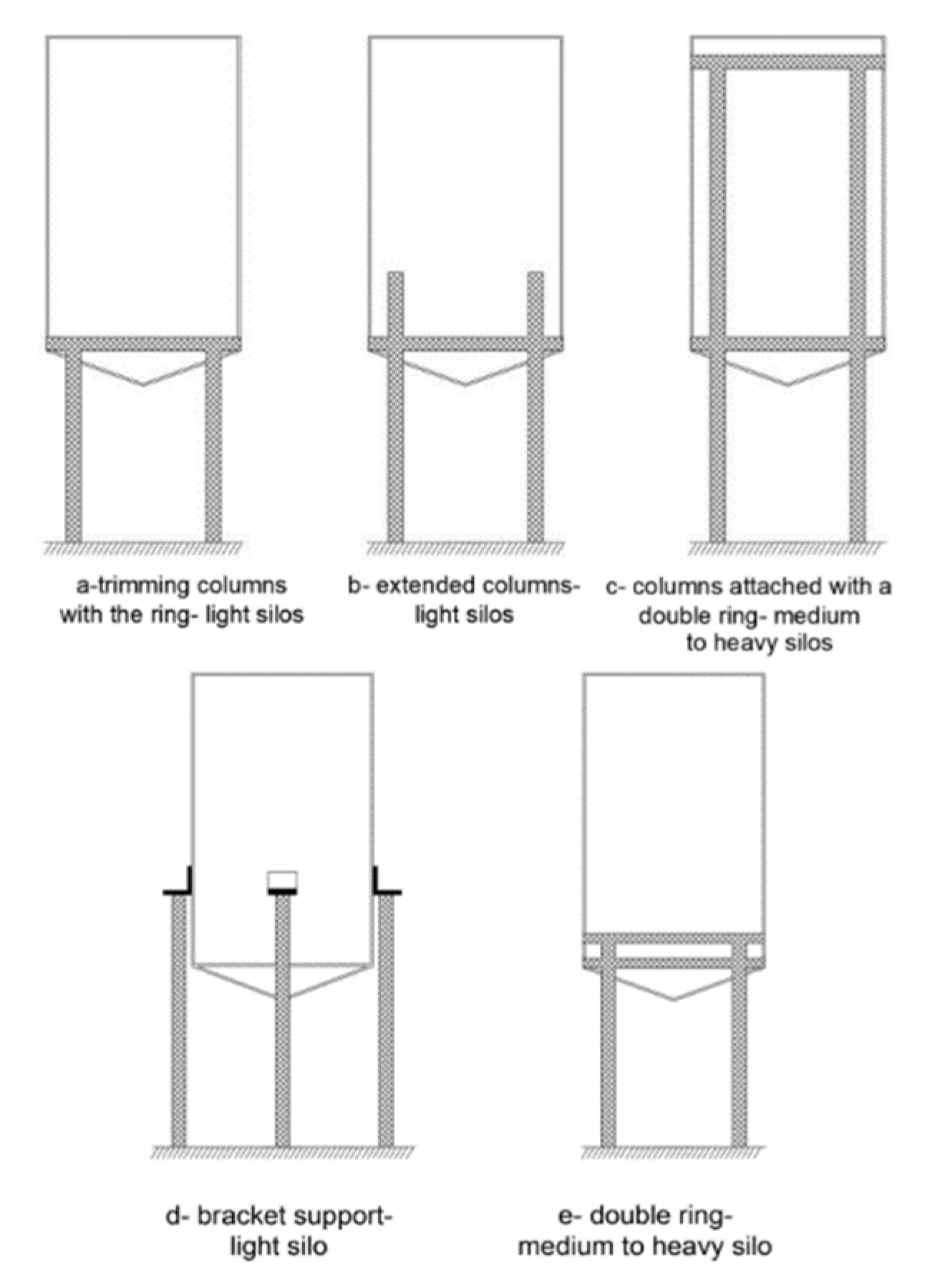
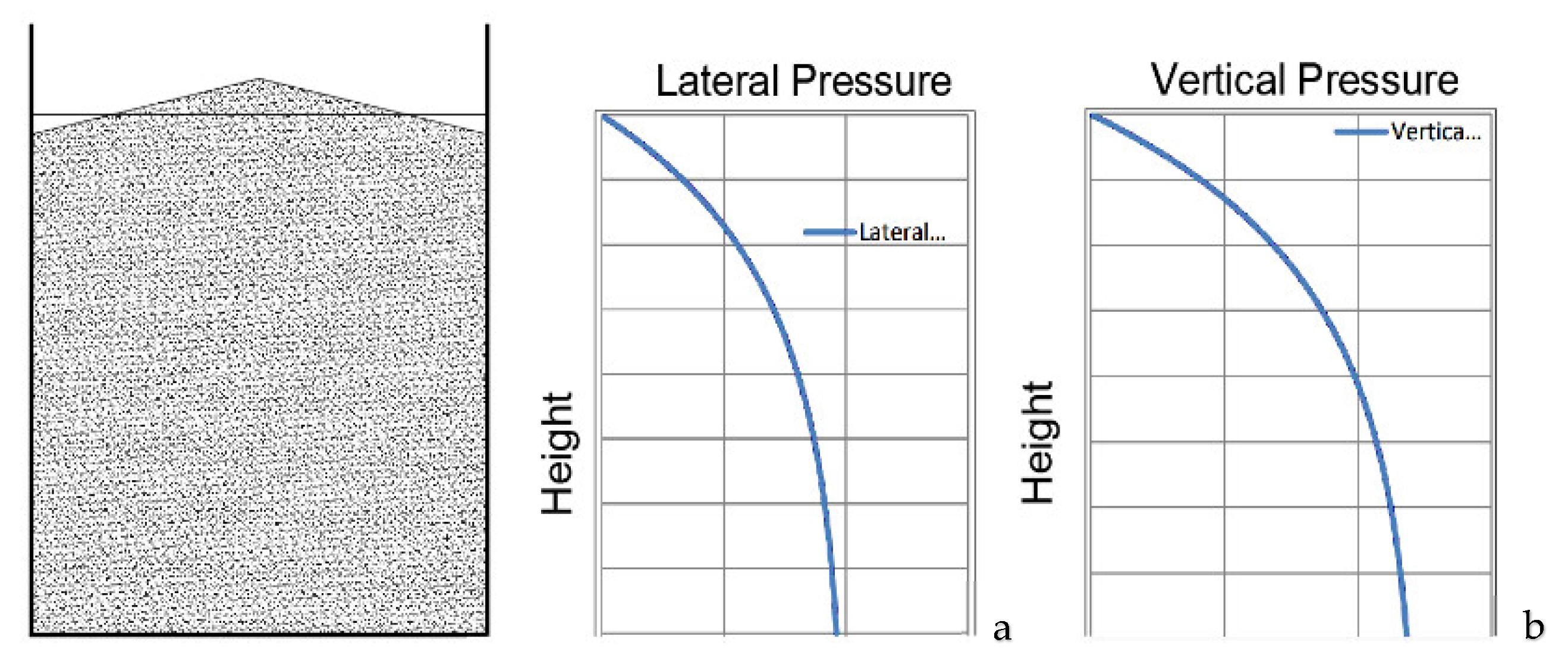
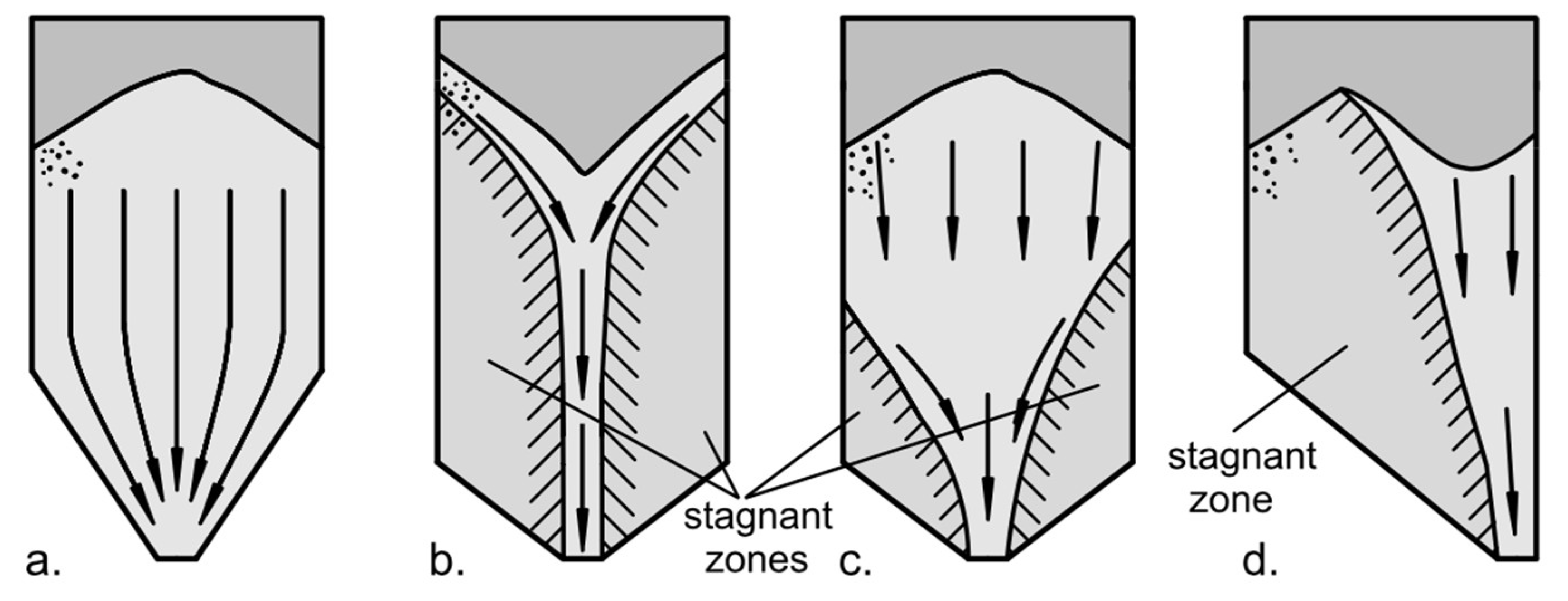
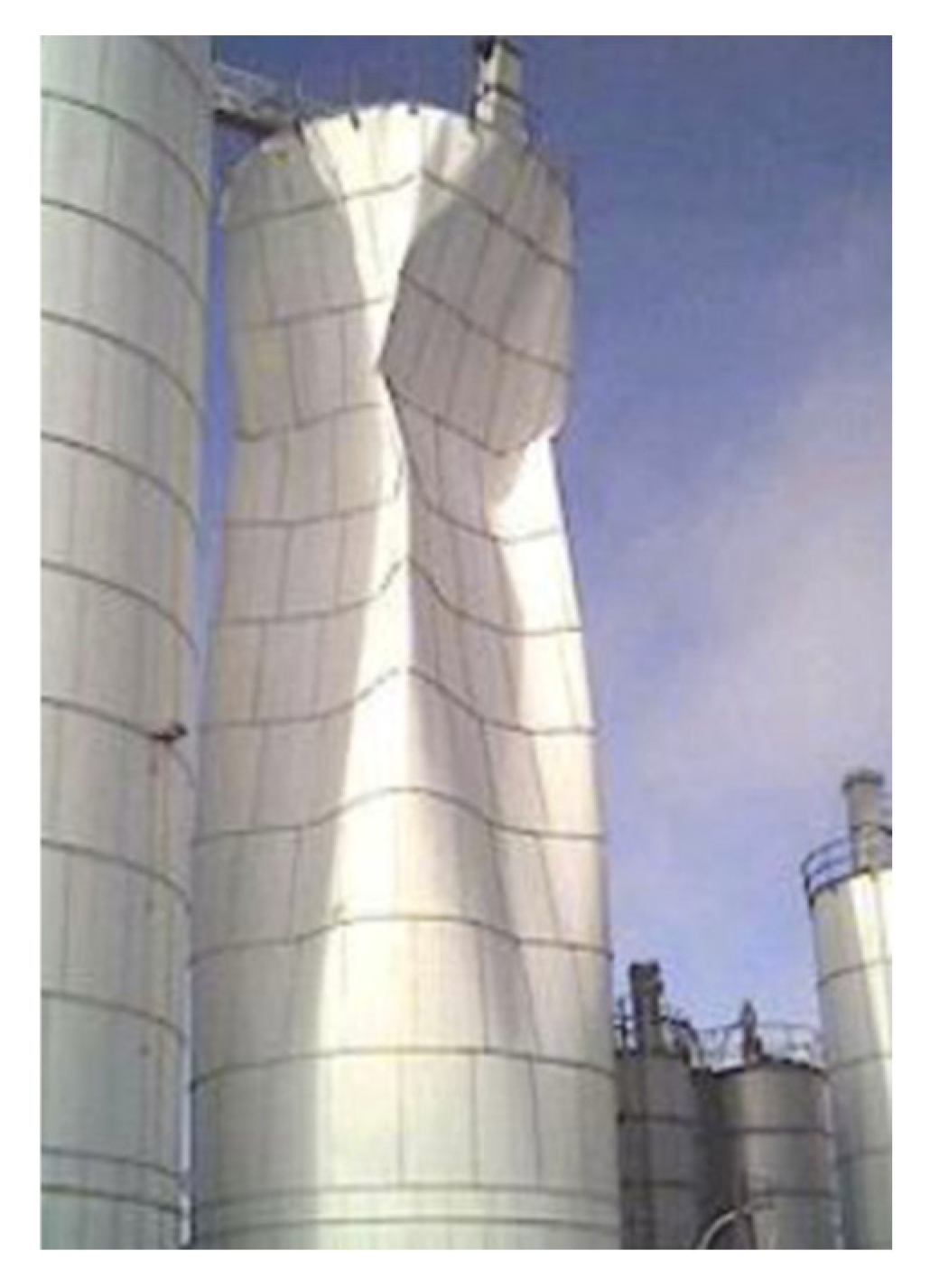
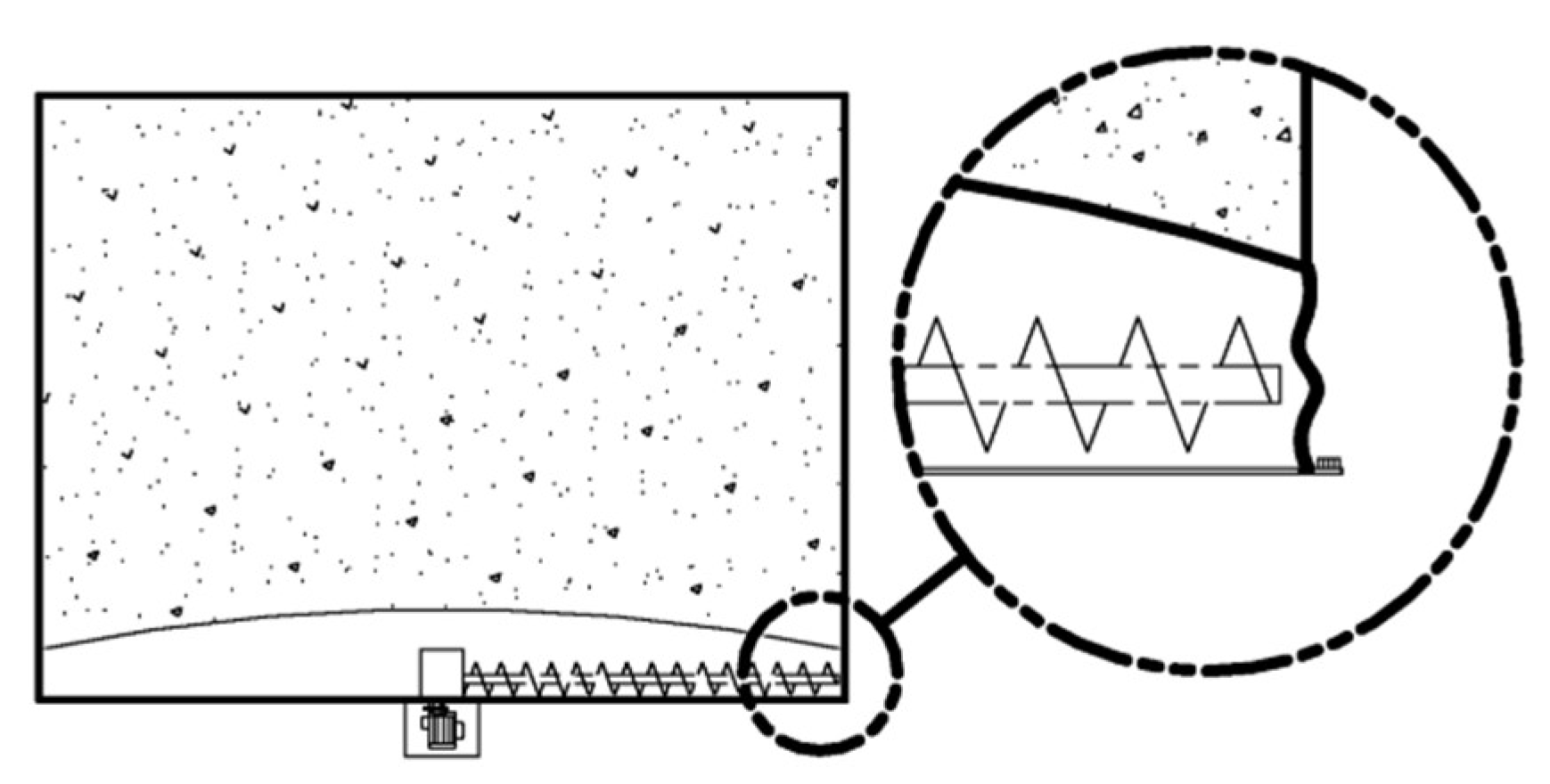

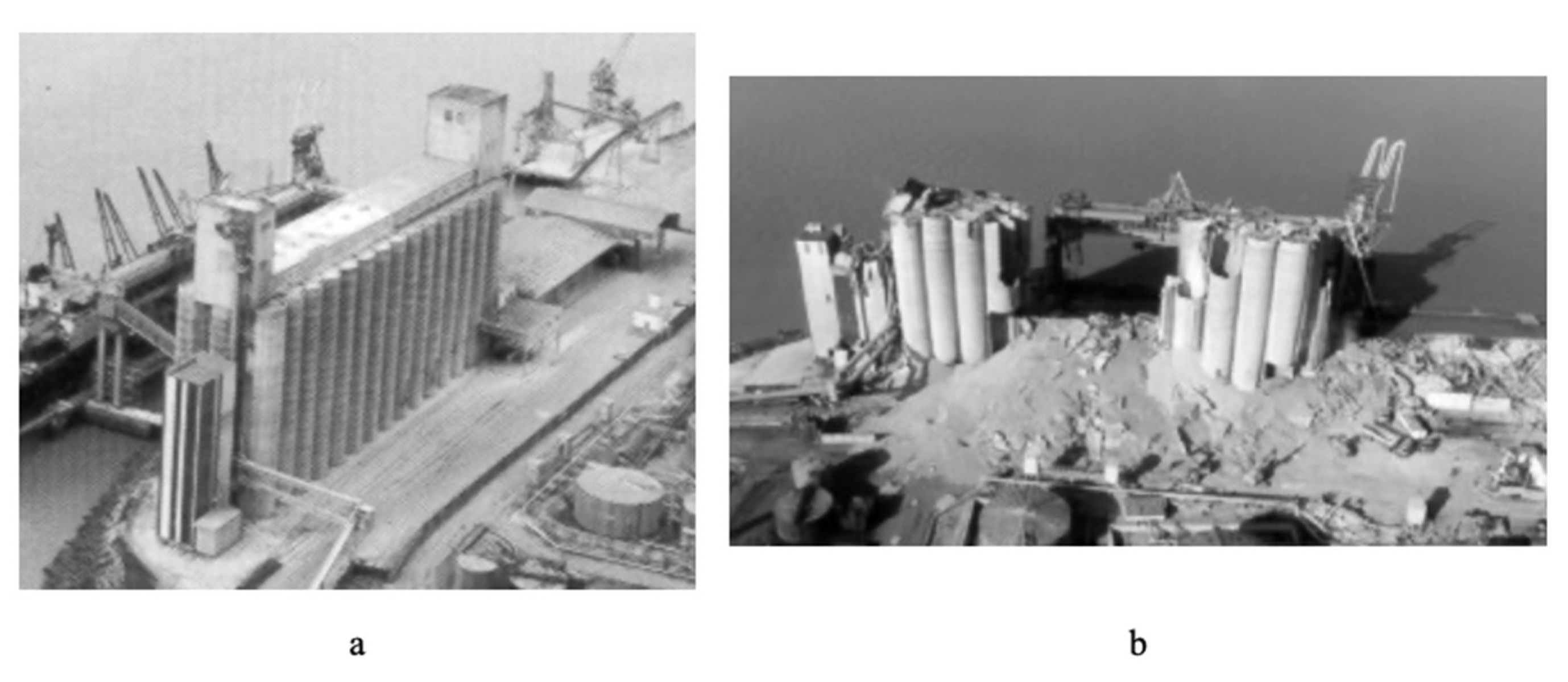
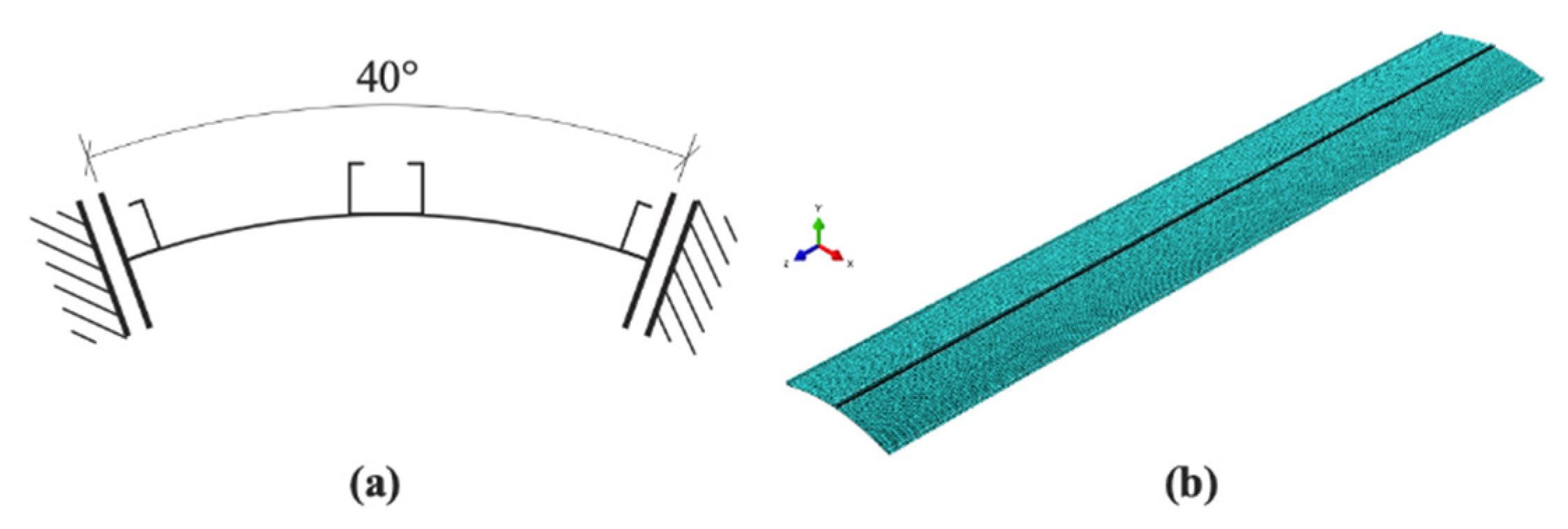
| Reference | Typology | Motivation | Stored Material | H/R | R/t | Specimen | Investigation Strategy |
|---|---|---|---|---|---|---|---|
| Jansseune et al. [38] | Elevated steel silos discretely supported on columns | Shell-column attachment, geometry improving. | Granular material | 8 | 200–1000 | Full scale | Numerical |
| Jansseune et al. [40] | Elevated steel silos discretely supported on columns | Failure modes and connection geometrical enhancements | Granular material | 8 | 1000 | Full scale | Numerical |
| Doerich and Rotter [41] | Elevated steel silos discretely supported on columns | Shell-column attachment and behavior description. | Granular material | 4 | 600 | Full scale | Numerical |
| Topkaya et al. [9,10] Zeybek et al. [37,43] | Elevated steel silos | Ring girder, stiffness criterion, arrangements of supporting system | - | - | - | - | Numerical |
| Winterstetter and Schmidt [55] | Steel cylindrical shell | Geometric imperfections | Empty | 2–4 | 94–148 | Scaled | Numerical/experimental |
| Teng and Song [56] | Steel cylindrical shells | Eigenmode, imperfections | Empty | 3 | 500 | Numerical | |
| Elishakoff et al. [58] | Cylindrical shells | Random imperfection | Empty | 1.4–1.95 | 386–681 | Scaled | Numerical |
| Hühne et al. [61] Castro et al. [32] | Composite cylindrical shells | Geometrical imperfection techniques- perturbation approaches | Empty | - | - | - | Numerical |
| Wagner et al. [59] | Composite cylindrical shells | Geometrical imperfection techniques- perturbation approaches | Empty | 3 | 330 | Scaled | Numerical |
| Arbelo et al. [65] | Composite cylindrical shells | Geometrical imperfection techniques- perturbation approaches | Empty | 2 | 200, 540 | Scaled | Numerical |
| Jiao et al. [62] | Steel cylindrical shell | Imperfection, SPLA, and MPLA | Empty | 0.75–0.6 | 667–833 | Scaled | Numerical/experimental |
| Kriegesmann et al. [60] | Composite cylindrical shells | Probabilistic imperfection approach | Empty | 2.04 | 500 | Scaled | Numerical/experimental |
| Khakimova et al. [63] | Composite cylindrical shells | Validation of the SPLA | Empty | 2 | 533 | Scaled | Numerical/experimental |
| Pircher and Bridge [66] | Steel circular silos, welding rolled steel strakes. | Circumferential weld-induced imperfection, residual stresses. | Empty | 3 | 100 | Full-scale | Numerical |
| Jansseune et al. [7] | Elevated steel silos | Imperfection forms modelling and investigation | Empty | 2–10 | 100–1000 | Scaled | Numerical |
| Ning and Pellegrino [17,49] | Isotropic/orthotropic wavy shells | Silo cross-sectional shape optimization. | - | 1.6, 2 | 555.5, 195 | Scaled | Numerical experimental |
| Rotter et al. [15] | Thin-walled flat-bottom steel silos | Buckling behavior under filling/discharging induced stresses | Granular material | 620–900 | 630–3940 | Scaled | Experimental |
| Sadowski and Rotter [67] | Flat-bottom steel silos | Eccentric discharge unsymmetrical pressure, slender silos | Wheat | 6 | 500–1000 | Full scale | Numerical |
| Sadowski and Rotter [16] | Flat-bottom steel silos | Eccentric discharge unsymmetrical pressure, slender silos | Cement | 10.4 | 278–833 | Full scale | Numerical |
| Jäger-Cañás and Pasternak [18] | Ring-stiffened steel cylindrical shell | Design ring stiffeners under axial compression | Liquid | 1 | 125–10000 | Full scale | Numerical |
| Rejowski and Iwicki [78] | Flat-bottom corrugated steel silos | Stability analysis of silo stiffeners | Bulk solids | 4.4 | 5347 | Full scale | Numerical |
| Li et al. [80] | Ring-stiffened cylindrical steel shell | Ring-stiffeners arrangements, buckling behavior | Empty | 0.78 | 796 | Scaled | Numerical/experimental |
| Batika et al. [19] | Isotropic metallic cylindrical shell | Elephant foot, buckling behavior, fibre-reinforced polymer | Empty | 1 | 1000 | Full scale | Numerical |
| Reference | Typology | Motivation | Stored Material | H/2R | R/t | Specimen | Investigation Strategy | Modelling Stored Material | Dynamic Excitation |
|---|---|---|---|---|---|---|---|---|---|
| Rotter and Hull [4] | Steel squat flat-bottom ground supported silos | Wall stresses, failure modes | Bulk solids | 0.125–2 | 250–1000 | Full-scale | Numerical (steel) | Elastic | Quasi-static force |
| Younan and Veletsos [20] | Rigid circular cylindrical tanks | Grain-induced pressure on walls | Viscoelastic solid | 0–5 | - | - | Analytical | Homogenous linear viscoelastic | Harmonic excitation, earthquake record |
| Veletsos and Younan [5] | Flexible circular cylindrical tanks | Wall flexibility response | Viscoelastic solid | 0–1.5 | - | - | Analytical | Homogenous linear viscoelastic | Harmonic excitation, earthquake record |
| Holler and Meskouris [86] | Flat-bottom ground-supported silos | Provisions of EN 1998-4, squat, and slender silos | Granular material | 1, 5 | 500, 600 | Full-scale | Numerical/ experimental | Hypoplastic | Synthetic records, harmonic excitation |
| Kanyilmaz and Castiglioni [35] | Elevated steel silos group | Seismic isolation silos | Chemical material | 3.8 | 146- 219 | Full-scale | Numerical(steel) | Lumped distributed mass model [97] | Spectra compatible natural records |
| Castiglioni and Kanyilmaz [97] | Elevated steel silos | Modelling techniques | Granular material | 1.75 | 676 | Full-scale | Numerical(steel) | Dracker-Prager, Lumped mass | Scaled natural records |
| Guo et al. [82] | Cylindrical-supporting RC silo (case study) | Seismic assessment and design | Granular material | 2.9 | 27.3 | Full-scale | Numerical (RC) | Hypoplastic | Natural records |
| Nateghi and Yakhchalian [89] | RC flat-bottom ground supported silos | Effect of granular material–structure interaction | Granular material | 2 | 16.6 | Full-scale | Numerical (RC) | Hypoplastic | Natural records |
| Yakhchalian and Nateghi [88] | Steel flat-bottom ground supported silos | Effect of granular material–structure interaction | Granular material | 1–5 | 120–500 | Full-scale | Numerical(steel) | Hypoplastic | Natural records |
| Silvestri et al. [21] | Flat-bottom ground-supported silos | Behavior of the stored grain | Grain-like material | 1 | - | Full-scale | Analytical | Analytical | Time-constant records |
| Pieraccini et at. [90] | Flat-bottom ground-supported silos | Analytical dynamic response | Grain-like material | 0.25–1 | - | Full-scale | Analytical | Analytical | Time-constant records |
| Pieraccini et al. [91] | Flat-bottom ground-supported silos | Vibration periods estimation | Coal, Ballottini glass | variant | - | variant | Analytical | Analytical | Harmonic signal, white noise |
| Silvestri et al. [85] | Flat-bottom ground-supported silos | Analytical dynamic response | Ballottini glass | 0–1 | 200 | Scaled | Experimental | Analytical | Harmonic signal, white noise |
| Durmuş and Livaoglu [92] | RC flat-bottom ground supported silo | Soil–structure interaction | Wheat | 0.75, 1.25 | 100 | Full scale | Analytical/Numerical | Visco-elastoplastic, hypoplastic | Natural records |
| Butenweg et al. [93] | Flat-bottom ground-supported steel silos | Seismic analysis of silos | Granular bulk materials | 1, 5 | 100, 75 | Full scale | Numerical | Hypoplastic | Static equivalent loads, Synthetic records |
| Mehretehran and Maleki [83,94] | Flat-bottom ground-supported steel silos | Dynamic buckling behavior | Camacho wheat | 0.72–2.25 0.8–2.5 | 500–1250 500–2500 | Full-scale | Numerical | Drucker-Prager | Natural records |
| Silvestri et al. [95] | Flat-bottom ground-supported steel silos, corrugated walls | Static pressure, dynamic properties | Wheat | 0.9 | 1820 | Full-scale | Experimental | Analytical | Harmonic signal, white noise |
| Jian et al. [96] | Flat-bottom ground-supported flexible steel silos (shallow) | Dynamic response, energy dissipation capacity | Wheat | 0–1 | 400 | Scaled | Experimental | Analytical | Natural records |
| Reference | Typology | Motivation | Failure Causes | Failure Modes | Usage | Content Material | Full/Partial Failure | Failure Reason |
|---|---|---|---|---|---|---|---|---|
| Mai [28] | RC silos | Failures in RC silos, durability, cause, mechanisms, strengthening | - | Multi-modes failure | - | Different cases with various dimensions | ||
| Rotter [113] | Silos and tanks (RC, steel) | Different typologies and imposed actions | - | Multi-modes failure | Industrial | Different cases with various dimensions | ||
| Maraveas [114] | RC silos (cast-in-place, precast silos) | Strengthen strategies | - | Multi-modes failure | Agriculture sector | Different cases with various dimensions | ||
| Rotter [115] | Steel silos | Design rules formulation | High internal pressure | Elephant’s foot buckling | General | Different cases with various dimensions | ||
| Carson and Holmes [116] | RC, steel silos | Failure reasons | Design, construction, utilization | - | Industrial (power plant) | Fly ash | Full collapse | Thermal ratcheting, construction cost-cutting measures |
| Carson and Jenkyn [117] | RC, steel silos | Failure reasons, causes, and the countermeasures | Design, construction, utilization, maintenance | Multi-modes failure | General | Different cases with various dimensions | ||
| Zaccari and Cudemo [29] | Steel silos | Failure reasons, strengthen strategies | Design deficiencies | Buckling failure | Industrial (power plant) | Limestone | Huge deformation | Eccentric discharge flow mis-assessment |
| Dogangun et al. [70] | RC, precast concrete, steel silos | Failure accidents | Explosions, asymmetrical loads, soil failure, earthquakes. | Multi-modes failure | Industry (food) | Corn | Full collapse | Bursting |
| Industrial (power plant) | Coal | Partial collapse | Internal failure | |||||
| Oxygen storge | Liquefied oxygen | Partial collapse | Supporting system failure | |||||
| Puzrin et al. [123] | RC silos battery | Failure of massive grain elevator | Soil failure | Soil failure | Grain storage for shipment | Grain | Partial soil failure | Geotechnical design deficiency |
| Basone et al. [130] | Steel tank | Reducing seismic failure risk, base isolation | Earthquake | Seismic damages | Fuel storage | Liquid | - | High pressure induced by ground motion |
| Kanyilmaz and Castiglioni [35] | Elevated steel silo group | Reducing seismic failure risk, base isolation | Earthquake | Seismic damage | Granular material storage | Sodium percarbonate | Partial failure | Steel supporting system failure |
| Sassine et al. [133] | Cylindrical steel tanks | Tank wall stresses over thermal cycles | thermal cycling and fluctuating | Thermal ratcheting | Industrial (power plant) | Granular | Full collapse | Thermal ratcheting |
| Tascón [139] | RC silos | Reducing explosion risk, ventilation system | Dust explosion | Explosion | Barley and wheat flour | Different cases with various dimensions | ||
| Reference | Typology | Motivation | Stored Material | H/R | R/t | Full Scale/Scaled | Investigation Strategy |
|---|---|---|---|---|---|---|---|
| Rosen and Singer [148] | Stiffened isotropic cylindrical shell, elastic edge restraints. | Boundary condition definition, system under axial loads | Empty | 1.25–1.5 | 486–520 | Scaled | Experimental |
| Singer and Abramovich [149] | Stiffened isotropic cylindrical shell, realistic boundary conditions | Practical boundary condition definition, system under axial loads | Empty | 0.92–1.28 | 467–477 | Scaled | Experimental |
| Arbelo et al. [145] | Unstiffened cylindrical shell (composite-carbon fiber fabric) | VCT for real boundary condition estimation, thin-walled shell structures | Empty | 1 | 300 | Scaled | Experimental |
| VCT for real boundary condition estimation, thin-walled shell structures | Empty | 2 | 408–1080 | Scaled | Numerical | ||
| Kalnins et al. [143] | Unstiffened cylindrical shell (steel and composite) | VCT for real boundary condition estimation, thin-walled shell structures | Empty | 2 | 478–800 | Scaled | Experimental |
| Skukis et al. [146] | Unstiffened cylindrical shell (composite) | VCT for real boundary condition estimation, thin-walled shell structures | Empty | 2 | 478 | Scaled | Experimental/ Numerical |
| Skukis et al. [150] | Isotropic cylindrical shell with cut-outs | VCT for buckling capacity estimation | Empty | 0.92 | 920 | Scaled | Experimental |
| Franzoni et al. [151] | Isotropic imperfection-sensitive cylindrical shells | VCT verification investigation, relationship between compressive load/natural frequency variation | Empty | 2 | 500–800 | Scaled | Analytical/numerical |
| Zmuda-Trzebiatowski and Iwicki [152] | Steel stiffened corrugated silos | Applicability of the VCT, estimation of the buckling load of silos. | Empty | 4.3 | 5360 | Full scale | Numerical |
| Ding et al. [31] Ding et al. [11] | Large-scale steel cylindrical silos | Imperfection measurement, Surface profile measurement system | Empty | 1.96 | 480–1000 | Full scale | Experimental |
| Morelli et al. [153] | Elevated steel silo group | Performance-based earthquake assessment | Filtered dust | - | - | Full scale | Numerical |
Publisher’s Note: MDPI stays neutral with regard to jurisdictional claims in published maps and institutional affiliations. |
© 2022 by the authors. Licensee MDPI, Basel, Switzerland. This article is an open access article distributed under the terms and conditions of the Creative Commons Attribution (CC BY) license (https://creativecommons.org/licenses/by/4.0/).
Share and Cite
Khalil, M.; Ruggieri, S.; Uva, G. Assessment of Structural Behavior, Vulnerability, and Risk of Industrial Silos: State-of-the-Art and Recent Research Trends. Appl. Sci. 2022, 12, 3006. https://doi.org/10.3390/app12063006
Khalil M, Ruggieri S, Uva G. Assessment of Structural Behavior, Vulnerability, and Risk of Industrial Silos: State-of-the-Art and Recent Research Trends. Applied Sciences. 2022; 12(6):3006. https://doi.org/10.3390/app12063006
Chicago/Turabian StyleKhalil, Mohammad, Sergio Ruggieri, and Giuseppina Uva. 2022. "Assessment of Structural Behavior, Vulnerability, and Risk of Industrial Silos: State-of-the-Art and Recent Research Trends" Applied Sciences 12, no. 6: 3006. https://doi.org/10.3390/app12063006
APA StyleKhalil, M., Ruggieri, S., & Uva, G. (2022). Assessment of Structural Behavior, Vulnerability, and Risk of Industrial Silos: State-of-the-Art and Recent Research Trends. Applied Sciences, 12(6), 3006. https://doi.org/10.3390/app12063006







